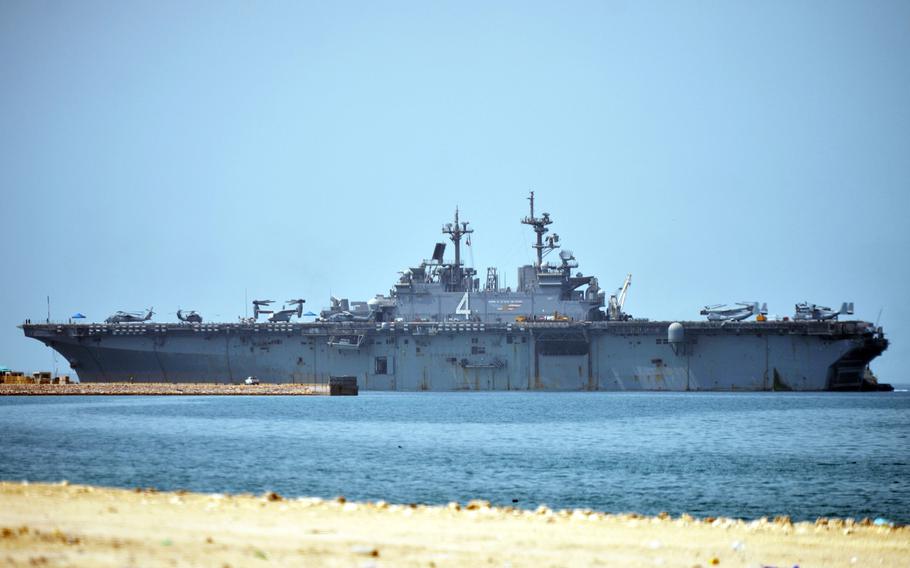
The amphibious assault ship USS Boxer arrives at Bahrain’s Khalifa bin Salman Port on Thursday, July 25, 2019, for a scheduled port visit. Last week, U.S. officials said the ship destroyed at least one Iranian drone while operating in the Persian Gulf. (Joshua Karsten/Stars and Stripes)
MANAMA, Bahrain — The USS Boxer pulled into Bahrain’s Khalifa bin Salman Port on Thursday for a visit, days after the amphibious assault ship made headlines for downing at least one Iranian drone in the Strait of Hormuz.
Boxer’s crew, roughly 2,000 sailors and Marines, are expected to rest and relax while in the kingdom, which lies across from Iran in the Persian Gulf. The command has not specified any activities while in port.
The ship reportedly engaged two drones as it transited to the Persian Gulf last week, taking defensive action against a fixed-wing drone that had flown “within a threatening range” on the morning of July 18. President Donald Trump, claiming it was an Iranian drone, said it was destroyed after coming within about 1,000 yards of the vessel.
The ship may have taken out a second unmanned aircraft during the incident, Gen. Kenneth McKenzie, head of U.S. Central Command, said to a CBS News reporter aboard the ship before its port call. The two engagements happened about an hour apart, he said, but he was only “confident” that one of the drones was brought down.
The drone was reportedly disabled by Marines of the 11th Marine Expeditionary Unit aboard the Boxer using an electronic jamming device known as a Light Marine Air Defense Integrated System, or LMADIS, as manned and unmanned Iranian aircraft swooped in near the warship.
It is believed to be the first “kill” for the LMADIS, USNI News reported, and likely cost less than alternatives like missiles.
Tehran has disputed Washington’s accounts of the incident, claiming that all of its drones in the region landed back at their bases that day. On Wednesday, Maj. Gen. Hossein Salami, head of the Iranian Revolutionary Guards Corps, repeated the denial, calling for the U.S. to produce evidence of the downed drone.
Last week, Iranian state media published about six minutes of video surveillance footage purportedly taken by the drones, which it said proved Tehran’s version of events. The clips, however, do not show the aircraft returning to base or landing.
The purported splashing of the drone comes about a month after Iranian forces shot down a U.S. military spy drone with a surface-to-air missile. U.S. officials claimed the drone was in international airspace over the Strait of Hormuz, while Tehran claimed the drone had ventured into Iranian airspace.
A chokepoint at the entrance to the Persian Gulf and a major thoroughfare for oil and other cargo, the narrow waterway has been a hot zone at the center of tensions with Iran in recent months. These included attacks on six commercial vessels since May that Washington has blamed on Tehran, and the seizure last week of a British oil tanker by Iranian patrol boats.
Boxer, along with attached 11th MEU and two support ships, arrived in Middle East waters in June, as the U.S. deployed troops and equipment to the region, including a carrier strike group and bomber task force, in response to what Washington said were increased threats against U.S. personnel or property from Iran or its proxy forces. Iran-backed militants are active in Yemen and Iraq.
Over the weekend, CENTCOM said it was preparing to send troops to Prince Sultan Air Base in Saudi Arabia — the first time in more than a decade that U.S. servicemembers will be deployed there — as part of about 2,000 additional forces being sent to the region.
CENTCOM is also developing an international maritime coalition to increase surveillance and security, and to ensure freedom of navigation in the Strait of Hormuz, the Gulf of Oman and the Persian Gulf, as well as the Bab el-Mandeb strait, which connects the Red Sea to the Gulf of Aden near Yemen, the command said last week. The U.S. is expected to provide surveillance and other support, and is seeking partner countries in Europe, the Middle East and elsewhere in Asia to escort vessels under their flags.
It was not immediately clear how long Boxer will remain pierside. The Navy’s 5th Fleet said only that it was a scheduled port call.
karsten.joshua@stripes.com Twitter: @joshua_karsten
garland.chad@stripes.com Twitter: @chadgarland